 W
WThe Ficedula flycatchers are a genus of Old World flycatchers. The genus is the largest in the family, containing around thirty species. They have sometimes been included in the genus Muscicapa. The genus is found in Europe, Asia and Africa. Several species are highly migratory, whereas other species are sedentary.
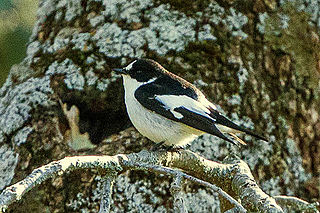 W
WAtlas pied flycatcher or Atlas flycatcher is a bird in an Old World flycatcher family, one of the four species of Western Palearctic black-and-white flycatchers; it is endemic as a breeding species to North-west Africa.
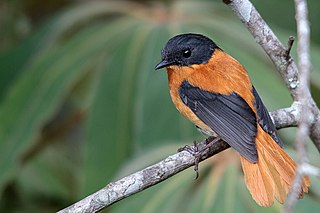 W
WThe black-and-orange flycatcher or black-and-rufous flycatcher is a species of flycatcher endemic to the central and southern Western Ghats, the Nilgiris and Palni hill ranges in southern India. It is unique among the Ficedula flycatchers in having rufous coloration on its back and prior to molecular studies was suggested to be related to the chats and thrushes.
 W
WThe black-banded flycatcher, also known as the Timor flycatcher, is a species of bird in the family Muscicapidae. In the past the species was considered to be related to the Australasian robins but this was as the result of convergent evolution. It is endemic to Timor island. The black-banded flycatcher is small with a broad bill and distinctive plumage. The species has a white belly, lower rump and throat with a thin black band across the chest. The tail, neck and wings are black and the back, upper wing and shoulders rich chestnut. The plumage of the head is sexually dichromatic, with the head being black in the males and dark grey in the females. The eye and bill is black and the feet and legs are yellow. The calls consist of soft whistles, some of which sound similar to the Timor stubtail.
 W
WThe cinnamon-chested flycatcher is a species of bird in the family Muscicapidae. It is found in Buru, Seram, and Kai Besar.
 W
WThe collared flycatcher is a small passerine bird in the Old World flycatcher family, one of the four species of Western Palearctic black-and-white flycatchers. It breeds in southeast Europe and Eastern France to the Balkan Peninsula and Ukraine and is migratory, wintering in sub Sahara Africa. It is a rare vagrant in western Europe.
 W
WThe cryptic flycatcher is a species of bird in the family Muscicapidae. It is endemic to the Philippines only being found in the island of Mindanao. Its natural habitat is tropical moist mid-montane forests from 600 - 1,500 meters.
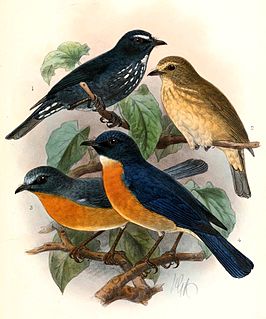 W
WThe Damar flycatcher is a species of bird in the family Muscicapidae. It is endemic to Indonesia.
 W
WThe European pied flycatcher is a small passerine bird in the Old World flycatcher family. One of the four species of Western Palearctic black-and-white flycatchers, it hybridizes to a limited extent with the collared flycatcher. It breeds in most of Europe and across the Western Palearctic. It is migratory, wintering mainly in tropical Africa. It usually builds its nests in holes on oak trees. This species practices polygyny, usually bigamy, with the male travelling large distances to acquire a second mate. The male will mate with the secondary female and then return to the primary female in order to help with aspects of child rearing, such as feeding.
 W
WThe Kashmir flycatcher is a small passerine bird in the flycatcher family Muscicapidae. At one time it was considered to be a subspecies of the red-breasted flycatcher, Ficedula parva.
 W
WThe little pied flycatcher is a species of bird in the family Muscicapidae. It is found in the Indian Subcontinent and Southeast Asia, ranging across Bangladesh, Bhutan, Cambodia, India, Indonesia, Laos, Malaysia, Myanmar, Nepal, the Philippines, Thailand, and Vietnam.
 W
WThe little slaty flycatcher is a species of bird in the family Muscicapidae. It is found on the islands of Mindanao, Leyte and Samar in the Philippines.
 W
WThe mugimaki flycatcher is a small passerine bird of eastern Asia belonging to the genus Ficedula in the Old World flycatcher family, Muscicapidae. The name "mugimaki" comes from Japanese and means "wheat-sower". The bird is also known as the robin flycatcher.
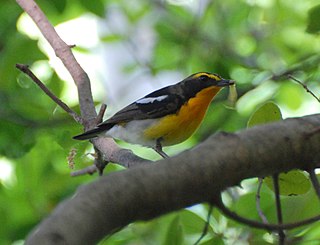 W
WThe narcissus flycatcher is a passerine bird in the Old World flycatcher family. It is native to the East Palearctic, from Sakhalin to the north, through Japan across through Korea, mainland China, and Taiwan, wintering in southeast Asia, including the Philippines, Vietnam and Borneo. It is highly migratory, and has been found as a vagrant from Australia in the south to Alaska in the north.
 W
WThe Palawan flycatcher is a species of bird in the family Muscicapidae. It is endemic to the Philippines found only in the region of Palawan. Its natural habitat is tropical moist lowland forests. It is threatened by habitat loss.
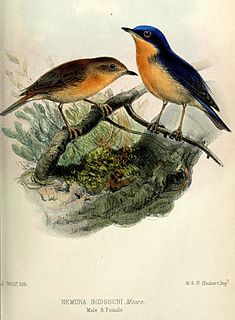 W
WThe pygmy flycatcher, also known as the pygmy blue-flycatcher, is a bird species of the family Muscicapidae.
 W
WThe red-breasted flycatcher is a small passerine bird in the Old World flycatcher family. It breeds in eastern Europe and across Central Asia and is migratory, wintering in south Asia. It is a regular passage migrant in western Europe, whereas the collared flycatcher which breeds further east is rare. This is because of the different migration direction.
 W
WThe rufous-chested flycatcher is a species of bird in the family Muscicapidae. It is found in Brunei, Indonesia, Malaysia, and Thailand. Its natural habitats are subtropical or tropical moist lowland forests and subtropical or tropical moist montane forests. It is threatened by habitat loss.
 W
WThe rufous-gorgeted flycatcher is a species of bird in the family Muscicapidae.
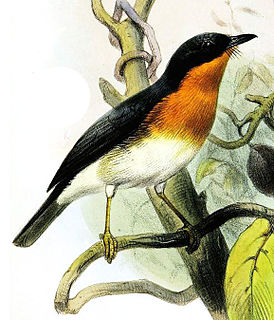 W
WThe rufous-throated flycatcher is a species of bird in the family Muscicapidae. It is endemic to Sulawesi, Indonesia. Its natural habitat is subtropical or tropical moist lowland forests. It is threatened by habitat loss.
 W
WThe rusty-tailed flycatcher is a small passerine bird in the flycatcher family Muscicapidae. It is found mainly in the northern regions of the Indian Subcontinent and some parts of southwest India, as well as pockets of Central Asia including Uzbekistan and Tajikistan. The species is partially migratory, with the Central Asian populations migrating to India, as far as the southwest Indian coast along the Arabian Sea, to Karnataka and Kerala.
 W
WThe sapphire flycatcher is a species of bird in the family Muscicapidae.
 W
WThe semicollared flycatcher is a small passerine bird in the Old World flycatcher family, one of the four species of Western Palearctic black-and-white flycatchers. It breeds in montane forests of the southeastern corner of Europe to Northwest Iran. It is migratory, wintering in Central and Eastern Africa. It is a rare vagrant in western Europe. Tracking studies using geolocators have revealed that weather conditions during spring migration can have a large impact on the timing of Semicollared flycatcher migration and survival of adult birds.
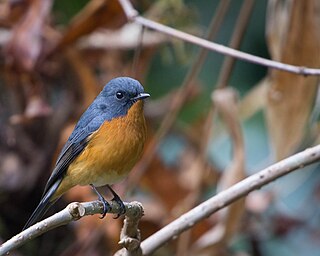 W
WThe slaty-backed flycatcher is a species of bird in the family Muscicapidae.
 W
WThe slaty-blue flycatcher is a species of bird in the family Muscicapidae.
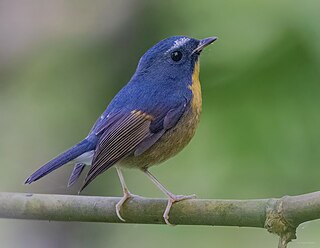 W
WThe snowy-browed flycatcher is a species of bird in the family Muscicapidae.
 W
WThe taiga flycatcher or red-throated flycatcher is a migratory bird in the family Muscicapidae. The species was first described by Peter Simon Pallas in 1811. The female has brown upper parts with a blackish tail flanked by white. The breast is buffish with underparts mostly white. The male has ear coverts and sides of the neck blue-tinged grey with breeding males having orange-red coloration on the throats. Unlike the taiga flycatcher, the female of the similar red-breasted flycatcher has brown tail while the red colour in breeding males extend up to the breast in red-breasted flycatcher. It breeds in northern Eurasia from eastern Russia to Siberia and Mongolia. It is a winter visitor to South and South-east Asia in Bangladesh, Bhutan, India, Cambodia, Laos, Myanmar, Nepal, Malaysia, Thailand, China, Vietnam, and Japan. Its natural habitat is taiga forest. It is a rare vagrant to western Europe.
 W
WThe Tanimbar flycatcher is a species of bird in the family Muscicapidae. It is found on the Tanimbar Islands. Its habitats are subtropical or tropical moist lowland forests and subtropical or tropical moist montane forests. It is threatened by habitat loss.
 W
WThe ultramarine flycatcher or the white-browed blue flycatcher is a small arboreal Old World flycatcher in the ficedula family that breeds in the foothills of the Himalayas and winters in southern India.
 W
WThe yellow-rumped flycatcher, Korean flycatcher or tricolor flycatcher is a species of flycatcher found in eastern Asia. A distinctive species with almost no look-alike other than the narcissus flycatcher. It breeds in eastern Asia including parts of Mongolia, Transbaikal, southern China, Korea and western Japan. They winter in parts of the Malay Peninsula and South Asia.